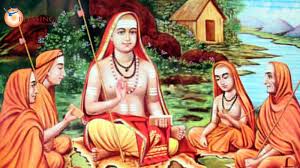ATMA BODHA 13
PANCHAPRANA –MANO BUDDHII DASA- INDRIYA-SAMANVITAM6
APANCHEEKRITA BHOOTOTHAM SUKSHMANGAM BHOGASADHANAM.
“The five Pranas, the ten organs, the manas and the buddhi formed from the rudimentary elements (or the Tanmatras) before their fivefold division and mutual combination with one another (pancheekarana)—this is thesubtle Body, the instrument of experience (of the individual”
Sri Sankara describes the nature of the Subtle Body in this verse. He has already explained the nature of the gross or physical body and how “Pancheekarana” takes place. There are vast differences in the creation of plants and animals, higher beings like the humans and the celestials. Behind this wonderful creation and the differences, there is a vibrant force that plays through all these various equipments. It is a wonder, why , in spite of a oneness of existence there is a series of different experiences in everyone. Vedanta deals about this question theoretically and practically. The answer given is quite convincing. The word PRANA is very significant. It is the manifestation of life in our body. The five pranas are the five departments of life’s activities. They function in five ways in our body
“ Pranapanas samananascho Dana Vyanoucha Vayavaha” “ Hrudi Prano gudepanas samano nabhi samsthitaha Udanah kanta desastho Vyanas sarva sareeragah” There are five pranas in every human being. They are 1 Prana 2 Apana 3 Samana 4 Udana and 5 Vyana. These five vayus or pranas govern all the activities of our body. How they work in our body is indicated below: 1Prana is the life force controlling and regulating the activities of our sense organs. This dynamic force energizes the activities of the sense organs. Prana is seated in our heart. 2 Apana is in charge of the excretory system of our body. It rejects the unwanted and poisonous things from the body. It is at the anal point of our body. 3 Samana is situated in the stomach and looks after the process of digestion and metabolism in the body. It distributes food to various parts of the body according to the need equally. Hunger is felt because of this vayu. It helps in the absorption of food and release of energy.4 Udana is seated in the neck region and is responsible for our speech and modulation of our voice. It helps man to evolve himself and peep into fresh fields of knowledge. Samana is situated at the navel point. 5 Vyana is the supervisor moving all over the body and examining if all vayus are functioning properly. Each Prana performs a different function in our physical body as each minister in charge of a given department. All of them are the expressions of the one government --LIFE – above.
Our sense organs like the eyes, ears and others are incapable of functioning without the help of these Pranas. The eyes are only instruments and cannot see by themselves. The power of vision issues forth through the mind intellect equipment. If the eyes do not come into contact with the mind intellect, there is no possibility for any vision. Thus the Subtle Body, formed by the five pranas, ten sense organs, the mind and the intellect, the instrument with which we experience pleasure and pain, is formed of the FIVE GREAT ELEMENTS named rudimentary elements or Tanmatras. But this is before their “Pancheeekarana. The physical or gross body serves as ”The Hall of Experience.” It is the Subtle Body that renders possible the enjoyment of the objects of the outer world. The Subtle Body is constituted of the instruments of experience.
Kenopanishad explains the importance of the Soul or Brahman in human life. “That which is not seen by the eye, but that by which the eyes are made to see----know that as the Brahman.
“That which is not heard by the ear, but that by which the ears are made to hear---know that as Brahman, and not what people worship here” I(Up i) 7, 8.
Brahman is none other than the Life giving Spirit or PRANA itself!!



